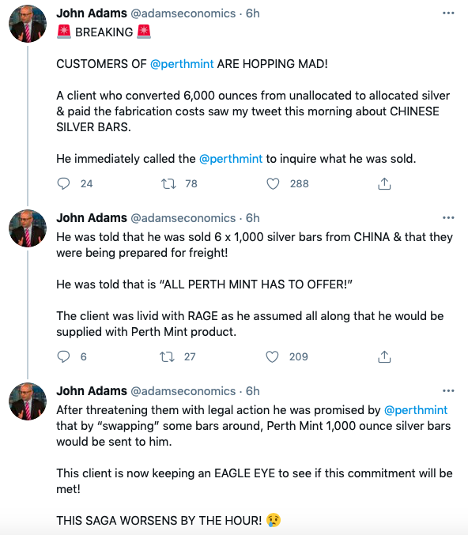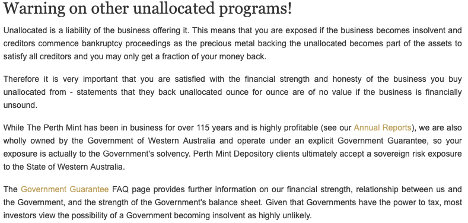Two weeks ago in this space, we brought to your attention a looming and growing problem within the fractional reserve bullion industry. The situation has seemingly gotten more dire in the past few days, so we thought we should write about it again today.
First of all, if you missed the post from last month, you should read it now. It contains all sorts of relevant information for today's update: When "Unallocated" Becomes Unavailable
But let's stop there. In the two weeks since, even more content on this subject has been added to this site and others. So for further background, you might check these links as well:
- What Do You Really Own With Unallocated Precious Metal? - Weekly Wrap Up
- Consolidation, Deliveries, and Is The Wait Over? - Weekly Wrap Up
- Thursday Conversation - John Adams of Adams Economics
The Australian economist John Adams has been spearheading the drive Down Under to bring attention to the unallocated and pooled metal programs offered by mints and bullion dealers in his country. He seems to be having great success in alerting folks to what they really own when they hold precious metal in unallocated form, and the movement to convert accounts from unallocated to allocated has seemed to stretch an already tight supply chain to the edge of breaking. See these most recent developments as an example:

So let's cut to the chase. Are these unallocated schemes illegal or somehow fraudulent? In most cases, the answer is plainly NO. These systems are designed legally, and the firms and their customers sign paperwork agreeing to all the terms of the accounts. So if you're a customer and you're happy with the unallocated arrangement—and the lower fees and storage costs that come with it—you would seemingly have nothing to worry about.
But here's the thing...
Do you truly understand what you signed up for? And do you recognize that, within these unallocated accounts, you don't fully own precious metal? What you own is exposure to price, and this is no different from owning one of the multitude of precious metal ETFs on the market. By holding GLD or SLV, you get exposure to price moves, but you should be under no illusion that you can access physical metal from these funds. Only the bullion banks that operate as "Authorized Participants" have that luxury. You as a shareholder only participate in price moves. If the time comes when you need physical metal, you have ZERO recourse for obtaining some from the fund.
And so it is with the unallocated accounts offered in Perth, Montreal, and Zurich...with one slight exception. Provided no one else is in line ahead of you, your unallocated account provider may be able to convert and deliver your physical metal if you give them enough lead time. However, if multiple other account holders beat you to it, chances are you'll be left holding the bag.
Don't believe me? Here's an important bit of verbiage taken directly from the Perth Mint website: https://www.perthmint.com/storage/help/faq-storage-options.html#what-is-unallocated-storage

So if push comes to shove and there's no metal for immediate conversion and delivery, at least the Perth Mint has the implied "Government Guarantee" to fall back upon when settling you in cash.
However, that's not necessarily the case with other unallocated programs. See this from Kitco in Canada: https://online.kitco.com/faq/kitco-pool-accounts

And again, there's nothing illegal about what's taking place here. These dealers have their terms, and their clients agree to them. The dealer makes money on the fractional reserve system, and the client seems to benefit from the lower storage and insurance costs.
This is no different from your local fiat bank. You may hold $100,000 in your savings account rather than stuffing the cash under your mattress. But if you show up one day demanding a withdrawal of your funds, the bank will very likely explain to you that they don't have your $100,000 just simply sitting in their vault. Instead, it has been loaned out and invested on behalf of the bank. You agreed to this when you opened the account.
If you give the bank a few days, they'll no doubt get you your cash. However, what happens if a large percentage of your bank's customers all appear at the same time and make the same withdrawal requests as you? Here's where it gets complicated. Who gets their cash out first? The first in line or those with the largest balances? And what happens if so many bank customers show up at once that the withdrawal demands overwhelm the bank's current liquidity?
Back in the day, this was called a "bank run". In 2021, a similar event at a bullion dealer might be called a "metal run" or something catchier. Regardless, this is always your risk if you participate in any sort of fractional reserve system.
So in closing, you MUST ask yourself why you purchased precious metal in the first place. Was it to diversify and protect your portfolio while at the same time removing all elements of counter-party risk? That's the most frequent answer given by precious metal investors who demanded immediate physical delivery and/or allocated storage of their metal, and it's most likely your answer too.
However, if the paragraph above correctly describes the goal of your precious metal investment, understand that you have not accomplished anything by holding unallocated metal. All you've obtained is exposure to price, and you've opened yourself up to the default risk of your counter-party dealer. Which is fine...until it isn't.
In the end, precious metal investors should demand physical precious metal only—fully allocated and with clear title. The old adage is: if you don't hold it, you don't own it. When it comes to precious metals, no truer words have ever been spoken.


